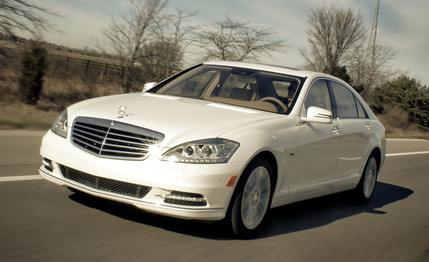
 Short Take Road Test
Short Take Road Test


In stark contrast to such luxury hybrids as the Lexus LS600hL and the new BMW 7-series hybrid—both of which, perplexingly, make more power than their less-green luxocruiser counterparts—Mercedes’ first hybrid, the S400, is surprisingly rational. Not only does it downsize from the S550’s 382-hp V-8 to a combined output of 295 horsepower (supplied by the corporate 3.5-liter V-6 and an electric motor), it also costs less. Whereas the Lexus and BMW hybrids come at a premium of tens of thousands of dollars, the S400 is the cheapest S-class, by $3650, starting at $88,825 (before an $1150 federal tax credit).
Transforming the S-class into a mild hybrid—it cannot run on electric power alone—is the addition of a roughly 65-pound, shoebox-size, 0.9-kilowatt-hour lithium-ion battery pack under the hood and a 50-pound electric motor sandwiched between the engine and a seven-speed automatic. Despite the additional weight of the hybrid gear, however, the S400, at 4594 pounds, is the lightest ninth-generation S-class we’ve tested.
The hybrid doesn’t have the deep power reserve of the effortless S550—you know, for when someone really needs to be shown who’s boss—and the V-6 can occasionally sound strained, but it isn’t exactly slow, either. Getting to 60 mph requires 7.1 seconds versus 5.3 for the last S550 we tested, and the quarter-mile, at 15.4 seconds, is slower by 1.5. The electric motor seamlessly fills in low-end torque, of which there’s still plenty for brake-torque burnouts
Mercedes says drivers won’t be able to feel whether braking is regenerative (using the electric motor) or conventional (using the friction brakes). That’s true, but only because the brake pedal is so numb that pretty much nothing can be felt, which is the S400’s only off-putting flaw. While slowing to a stop, the engine switches off; the electric motor restarts it as soon as the brake pedal is released, which is actually smoother and quicker than a typical, nonhybrid start sequence. If the engine is silenced for more than just 0.7 second, says Mercedes, it saves more gas than is required to refire the V-6.
Speaking of which, EPA fuel economy jumps from 15 mpg city and 23 highway to 19 and 26, respectively. On a mostly highway trip—but with no shortage of wide-open-throttle on-ramp charges—we averaged a remarkable 27 mpg. Overall, we got 24 mpg, same as the last VW GTI we tested.
Although the luxobarge class has shrunk by about 40 percent in the past year, the S-class remains the sales king, and adding this sensible S400 certainly can’t hurt. In fact, Mercedes says the hybrid is already making up about 10 percent of the mix. What car service, for example, wouldn’t want a less expensive S-class that also chugs less gas? After all, the back seat is still just as tranquil and commodious. And that’s the best part: Hybrid or not, the S-class retains the enviable position of being the closest automotive approximation of four La-Z-Boys flying in close formation.